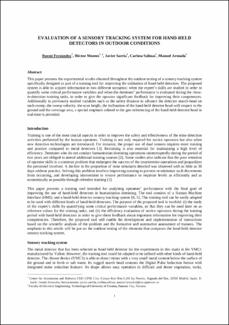El sistema se apagará debido a tareas habituales de mantenimiento. Por favor, guarde su trabajo y desconéctese.
Evaluation of a Sensory Tracking System for Hand-held Detectors in Outdoor Conditions
| dc.contributor.author | Fernández, Roemi | |
| dc.contributor.author | Montes Franceschi, Héctor | |
| dc.contributor.author | Sarria, Javier | |
| dc.contributor.author | Salinas, Carlota | |
| dc.contributor.author | Armada, Manuel | |
| dc.date.accessioned | 2017-08-01T13:49:20Z | |
| dc.date.accessioned | 2017-08-01T13:49:20Z | |
| dc.date.available | 2017-08-01T13:49:20Z | |
| dc.date.available | 2017-08-01T13:49:20Z | |
| dc.date.issued | 2013-07-05 | |
| dc.date.issued | 2013-07-05 | |
| dc.identifier.uri | http://ridda2.utp.ac.pa/handle/123456789/2396 | |
| dc.identifier.uri | http://ridda2.utp.ac.pa/handle/123456789/2396 | |
| dc.description | This paper presents the experimental results obtained throughout the outdoor testing of a sensory tracking system specifically designed as part of a training tool for improving the utilisation of hand-held detectors. The proposed system is able to acquire information in two different scenarios: when the expert’s skills are studied in order to quantify some critical performance variables and when the deminers’ performance is evaluated during the close- in-detection training tasks, in order to give the operator significant feedback for improving their competences. Additionally to previously studied variables such as the safety distance to advance the detector search-head on each sweep, the sweep velocity, the scan height, the inclination of the hand-held detector head with respect to the ground and the coverage area, a special emphasis related to the geo-referencing of the hand-held detector head in real-time is provided. | en_US |
| dc.description.abstract | This paper presents the experimental results obtained throughout the outdoor testing of a sensory tracking system specifically designed as part of a training tool for improving the utilisation of hand-held detectors. The proposed system is able to acquire information in two different scenarios: when the expert’s skills are studied in order to quantify some critical performance variables and when the deminers’ performance is evaluated during the close- in-detection training tasks, in order to give the operator significant feedback for improving their competences. Additionally to previously studied variables such as the safety distance to advance the detector search-head on each sweep, the sweep velocity, the scan height, the inclination of the hand-held detector head with respect to the ground and the coverage area, a special emphasis related to the geo-referencing of the hand-held detector head in real-time is provided. | en_US |
| dc.language | eng | |
| dc.language.iso | eng | en_US |
| dc.rights | https://creativecommons.org/licenses/by-nc-sa/4.0/ | |
| dc.rights | info:eu-repo/semantics/openAccess | |
| dc.subject | hand-held detectors | en_US |
| dc.subject | sensory tracking system | en_US |
| dc.subject | georeferenced system | en_US |
| dc.subject | real time | en_US |
| dc.subject | deminers training | en_US |
| dc.subject | hand-held detectors | |
| dc.subject | sensory tracking system | |
| dc.subject | georeferenced system | |
| dc.subject | real time | |
| dc.subject | deminers training | |
| dc.title | Evaluation of a Sensory Tracking System for Hand-held Detectors in Outdoor Conditions | en_US |
| dc.type | info:eu-repo/semantics/article | |
| dc.type | info:eu-repo/semantics/publishedVersion |
